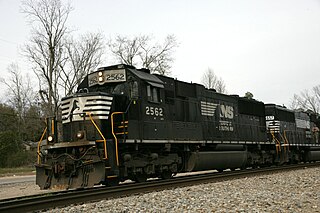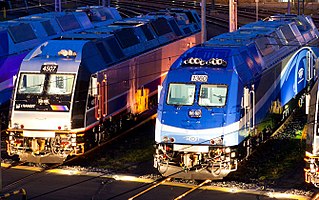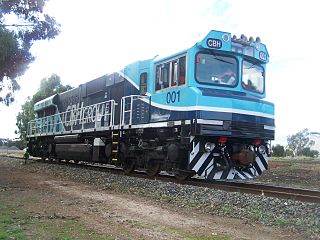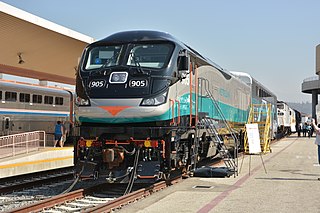
A cowl unit is a diesel locomotive with full-width, enclosing bodywork, similar in appearance to the cab unit-style of earlier locomotives, such as the EMD F-units of the 1940s and 1950s. The term cowl unit is of North American origin, although similarly-styled locomotives exist elsewhere.

The EMD F40PH is a four-axle 3,000–3,200 hp (2.2–2.4 MW) B-B diesel-electric locomotive built by General Motors Electro-Motive Division in several variants from 1975 to 1992. Intended for use on Amtrak's short-haul passenger routes, it became the backbone of Amtrak's diesel fleet after the failure of the EMD SDP40F. The F40PH also found widespread use on commuter railroads in the United States and with VIA Rail in Canada. Additional F40PH variants were manufactured by Morrison-Knudsen and MotivePower between 1988 and 1998, mostly rebuilt from older locomotives.

The EMD SD70 is a series of diesel-electric locomotives produced by the US company Electro-Motive Diesel in response to the GE Dash 9-44CW. This locomotive family is an extension and improvisation to the EMD SD60 series. Production commenced in late 1992 and since then over 5,700 units have been produced; most of these are the SD70M, SD70MAC, and SD70ACe models. While the majority of the production was ordered for use in North America, various models of the series have been used worldwide. All locomotives of this series are hood units with C-C trucks, except the SD70ACe-P4 and SD70MACH which have a B1-1B wheel configuration, and the SD70ACe-BB, which has a B+B-B+B wheel arrangement.

The EMD SD90MAC is a model of 6,000 hp (4,470 kW) C-C diesel-electric locomotive produced by General Motors Electro-Motive Division (EMD). It is, with the SD80MAC, one of the largest single-engined locomotives produced by EMD, surpassed only by the dual-engined DDA40X.

The Evolution Series is a line of diesel locomotives built by GE Transportation Systems, initially designed to meet the U.S. EPA's Tier 2 locomotive emissions standards that took effect in 2005. The line is the direct succesor to the GE Dash 9 Series. The first pre-production units were built in 2003. Evolution Series locomotives are equipped with either AC or DC traction motors, depending on the customer's preference. All are powered by the GE GEVO engine.

The EMD F59PH is a four-axle 3,000 hp (2 MW) B-B diesel-electric locomotive built by General Motors Electro-Motive Division from 1988 to 1994. A variant, the F59PHI, was produced from 1994 to 2001. The F59PH was originally built for GO Transit commuter operation in the Toronto region. Metrolink in Southern California also purchased a fleet for its 1992 launch. The streamlined F59PHI was designed for Amtrak California intercity service. A total of 72 F59PH and 83 F59PHI locomotives were built.

In rail transport, head-end power (HEP), also known as electric train supply (ETS), is the electrical power distribution system on a passenger train. The power source, usually a locomotive at the front or 'head' of a train, provides the electricity used for heating, lighting, electrical and other 'hotel' needs. The maritime equivalent is hotel electric power. A successful attempt by the London, Brighton and South Coast Railway in October 1881 to light the passenger cars on the London to Brighton route heralded the beginning of using electricity to light trains in the world.

The EMD F45 is a C-C cowled diesel-electric locomotive built by General Motors Electro-Motive Division between 1968 and 1971. Power was provided by an EMD 645E3 20-cylinder engine which generated 3,600 hp (2,680 kW).

The EMD F40C is a 6-axle 3,200 horsepower (2.4 MW) diesel-electric locomotive built by General Motors Electro-Motive Division in 1974 for commuter service in Chicago. EMD only built 15 locomotives; the decline of the 6-axle design for passenger service led to the adoption of the 4-axle EMD F40PH as the standard passenger locomotive in the United States. Along with a small fleet of HEP-equipped EMD SD70MAC locomotives operating on the Alaska Railroad, the F40Cs were the last six-axle passenger locomotives in daily service in North America until the delivery of Metra's first SD70MACH in 2022.

The U34CH was a 3,600 hp (2,700 kW) passenger diesel locomotive built by General Electric between 1970 and 1973. In total, 33 U34CH units were built; 32 were built for the New Jersey Department of Transportation and operated by the Erie Lackawanna Railway and, later, Conrail, with the last unit coming as a later rebuild of a GE U30C for the New York MTA.

The passenger locomotives derivatives of the General Motors EMD GP40 diesel-electric locomotive have been, and continue to be, used by multiple passenger railroads in North America. For passenger service, the locomotives required extra components for providing steam or head-end power (HEP) for heating, lighting and electricity in passenger cars. Most of these passenger locomotives were rebuilt from older freight locomotives, while some were built as brand new models.

The Bombardier ALP-45DP is a type of single cab dual-mode locomotive operated by New Jersey Transit and Exo. The locomotive was designed and originally built by Bombardier, which was bought by Alstom, which will complete the second order of locomotives.
GO Transit, the interregional public transit system in Southern Ontario, has a number of various road and rail vehicles. This includes 91 locomotives, 979 train coaches, and 752 buses.

The EMD GP22ECO is a 2,150 hp (1,600 kW) B-B diesel-electric locomotive rebuilt by Electro-Motive Diesel and Norfolk Southern's Juniata Shops. Initially EMD built two GP22ECO demonstrators, one based on a GP9 and one based on a GP40, but thus far all orders have been for conversions based on EMD GP40 and EMD GP40-2 series locomotives. The rebuild involves replacing the existing prime mover with an EPA Tier-II-compliant turbocharged V8 710G3A, with Electronic fuel injection. The prime mover is mated to an AR10 alternator for traction power, a CA6 alternator for control power, and a computerized control system. Applying this to a 6-axle locomotive results in a SD22ECO. Some 6-axle locomotives could alternately be converted into a SD32ECO, using a 3,150 hp (2,350 kW) V12 instead.

The MPI HSP46 is a four-axle AC-traction diesel-electric locomotive for commuter trains, designed and assembled by MotivePower. It meets EPA Tier 3 emissions standards. The launch customer is the Massachusetts Bay Transportation Authority (MBTA), whose first unit entered revenue service in April 2014.

The MPI MP33C is a model of diesel-electric freight locomotives designed and built by MotivePower in Boise, Idaho, USA. To date all orders have been for Australian operators.

The EMD F125 "Spirit" is a four-axle passenger diesel locomotive manufactured by Electro-Motive Diesel (EMD) for the North American market since 2015. It is powered by a Caterpillar C175-20 V20 diesel engine rated at 4,700 hp (3,500 kW). The locomotive is capable of traveling at a maximum in-service speed of 125 mph (201 km/h) pulling consists of up to 10 cars. It was EMD's first new passenger locomotive for the North American market in 15 years, with the most recent predecessor passenger locomotive being the EMD DE30AC and DM30AC built for the Long Island Rail Road. So far, Metrolink is the only customer of the F125.

The Siemens Charger is a family of diesel-electric/dual-mode passenger locomotives designed and manufactured by Siemens Mobility for the North American market.

GO Transit rail services are provided throughout the Greater Toronto and Hamilton Area (GTHA) and the Greater Golden Horseshoe. The GO Transit rail fleet consists of 90 MPI MP40 locomotives and 979 Bombardier BiLevel Coaches. In 2023, the system had a ridership of 40,807,100 passengers per year. GO Transit started on May 23, 1967, running single-deck trains powered by diesel locomotives in push-pull configuration on a single rail line along Lake Ontario's shoreline. When GO trains began operation, they ran on tracks mostly owned the two major freight railways of Canada: Canadian National (CN) and CPKC. Over time, GO Transit have acquired tracks, ensuring GO Transit has control over track maintenance and expansion. Metrolinx currently owns 80% of the GO's rail corridors.
MotivePower, Inc. (MPI) is an American manufacturer of diesel-electric locomotives. The company is a wholly-owned subsidiary of Wabtec, and traces its history back to the MK Rail division of Morrison-Knudsen.
























